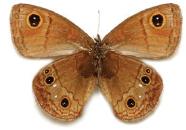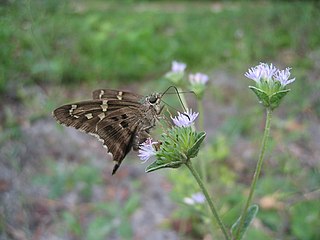Picrodendron is a genus of plant in the family Picrodendraceae, described in 1859. It contains one species, Picrodendron baccatum, native to the West Indies.

Papilio demoleus is a common and widespread swallowtail butterfly. The butterfly is also known as the lime butterfly, lemon butterfly, lime swallowtail, and chequered swallowtail. These common names refer to their host plants, which are usually citrus species such as the cultivated lime. Unlike most swallowtail butterflies, it does not have a prominent tail. When the adult stage is taken into consideration, the lime swallowtail is the shortest-lived butterfly, with male adults dying after four days and females after a week. The butterfly is native to Asia and Australia, and can be considered an invasive pest in other parts of the world. The butterfly has spread to Hispaniola island in the Western Hemisphere, and to Mahé, Seychelles.

Nesophontes, sometimes called West Indies shrews, is the sole genus of the extinct, monotypic mammal family Nesophontidae in the order Eulipotyphla. These animals were small insectivores, about 5 to 15 cm long, with a long slender snout and head and a long tail. They were endemic to the Greater Antilles, in Cuba, Hispaniola, Puerto Rico, the United States Virgin Islands, and the Cayman Islands.

Calisto is a butterfly genus from the subfamily Satyrinae in the family Nymphalidae. The genus was erected by Jacob Hübner in 1823. Members of the genus occur on the Caribbean islands only. Of the 44 species that are currently thought to exist, eleven occur on Cuba, one on Puerto Rico, one on Anegada Island, one on Jamaica, two on the Bahamas and twenty-eight on Hispaniola.

Pimenta is a genus of flowering plants in the myrtle family, Myrtaceae described as a genus in 1821. It is native to Central and South America, Mexico, and the West Indies.

The long-tailed skipper is a spread-winged skipper butterfly found throughout tropical and subtropical South America, south to Argentina and north into the eastern United States and southern Ontario. It cannot live in areas with prolonged frost. It is a showy butterfly, with wings of light brown tinted with iridescent blue, and two long tails extending from the hindwings. The robust body is light blue dorsally. It has a large head, prominent eyes, and a wingspan between 4.5 and 6 centimeters.

The western pygmy blue is one of the smallest butterflies in the world and the smallest in North America. It has reached Hawaii, as well as the Persian Gulf, including eastern Saudi Arabia, Bahrain and the United Arab Emirates.

The Miami blue is a small butterfly that is native to coastal areas of southern Florida. It is a subspecies of Thomas's blue. Once common throughout its range, it has become critically endangered, and is considered to be near extinction. Its numbers have recently been increased by a captive breeding program at the Florida Museum of Natural History.

The Cuban rock iguana, also known as the Cuban ground iguana or Cuban iguana, is a species of lizard of the iguana family. It is the second largest of the West Indian rock iguanas, one of the most endangered groups of lizards. A herbivorous species with a thick tail and spiked jowls, it is one of the largest lizards in the Caribbean.
The Caribbean bioregion is a biogeographic region that includes the islands of the Caribbean Sea and nearby Atlantic islands, which share a fauna, flora and mycobiota distinct from surrounding bioregions.

Battus polydamas, also known as the gold rim swallowtail, the Polydamas swallowtail or the tailless swallowtail, is a species of butterfly in the family Papilionidae. The species was first described by Carl Linnaeus in his 10th edition of Systema Naturae, published in 1758.

Anaea troglodyta, the Florida leafwing, Portia or Florida goatweed butterfly, is a butterfly of the family Nymphalidae. It is found in southern Florida and on many islands of the Caribbean. In Jamaica, it is known as the Jamaican tropical leafwing and in the Cayman Islands and Cuba it is known as the Cuban red leaf.

Junonia genoveva, the mangrove buckeye, is a butterfly of the family Nymphalidae. The species was first described by Pieter Cramer in 1780. It is found in South America, and possibly into Central America.

Papilio andraemon, the Bahaman swallowtail, is a swallowtail butterfly of the subfamily Papilioninae. It is found on the Bahamas, Cuba, Jamaica and the Cayman Islands. It is a rare stray or temporary colonist of the Florida Keys or the mainland near Miami.
Sauroplasma is a genus of parasites of the phylum Apicomplexa.

Papilio machaonides, the machaonides swallowtail, is a species of Neotropical swallowtail butterfly from the genus Papilio that is found in Hispaniola and is also thought to inhabit the Cayman Islands.

Hemiargus hanno, the hanno blue is a species of butterfly in the family Lycaenidae. It is found in Suriname, Brazil, Colombia, Cuba, the Netherlands Antilles, Puerto Rico and Hispaniola.

Borrichia arborescens is a species of flowering plant in the family Asteraceae known by the common name tree seaside tansy. It is native to the Yucatán Peninsula, Cuba, Jamaica, Bahamas, Cayman Islands, Hispaniola, Puerto Rico, Bermuda, the Florida Keys, and other islands in the region. It is found on rocky and sandy coasts, in both beaches and marshes.

Anaea are a genus of charaxine butterflies in the brush-footed butterfly family Nymphalidae. The butterflies are commonly known as leafwings. Members of the genus are found throughout the United States, Central America, and the Caribbean.

















